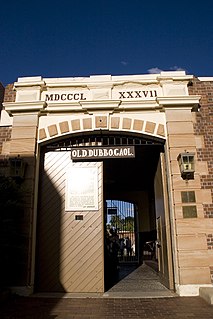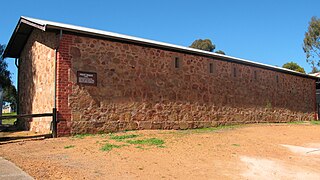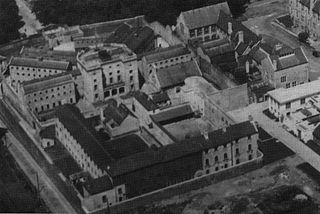
Her Majesty's Prison Pentridge was an Australian prison that was first established in 1851 in Coburg, Victoria. The first prisoners arrived in 1851. The prison officially closed on 1 May 1997.

The Old Melbourne Gaol is a museum on Russell Street, in Melbourne, Victoria, Australia. It consists of a bluestone building and courtyard, and is located next to the old City Police Watch House and City Courts buildings. It was first constructed starting in 1839, and during its operation as a prison between 1842 and 1929, it held and executed some of Australia's most notorious criminals, including bushranger Ned Kelly and serial killer Frederick Bailey Deeming. In total, 135 people were executed by hanging. Though it was used briefly during World War II, it formally ceased operating as a prison in 1924; with parts of the gaol being incorporated into the RMIT University, and the rest becoming a museum.

H.M. Gaol Hobart or Campbell Street Gaol, a former Australian maximum security prison for males and females, was located in Hobart, Tasmania. Built by convict labour, the gaol operated between 1821 until the early 1960s. In 1961, male inmates were transferred to the H.M. Risdon Prison and in 1963, female inmates were transferred to the Risdon Women's Prison.

The Maitland Gaol, also known as Maitland Correctional Centre, is a heritage-listed former Australian prison located in East Maitland, New South Wales. Its construction was started in 1844 and prisoners first entered the gaol in 1848. By the time of its closure, on 31 January 1998, it had become the longest continuously-run gaol in Australia. It has since been turned into a museum and is a popular tourist attraction. It was added to the New South Wales State Heritage Register on 2 April 1999.

The Berrima Correctional Centre is an Australian prison, located at Berrima, New South Wales. The Centre was operational between 1839 and 2011 with a number of breaks in between, and was re-opened in September 2016. Initially established as Berrima Gaol, the facility closed in 1909 and reopened in 1949 as the Berrima Training Centre. The Centre is the oldest Australian correctional facility in operation. It was added to the New South Wales State Heritage Register on 2 April 1999.

Berrima is a historic village in the Southern Highlands of New South Wales, Australia, in Wingecarribee Shire. The village, once a major town, is located on the Old Hume Highway between Canberra and Sydney. It was previously known officially as the Town of Berrima. It is close to the three major towns of the Southern Highlands; Mittagong, Bowral and Moss Vale.

The Perth Gaol was a gaol (jail) built in Perth, the state capital of Western Australia, between 1854 and 1856 to house convicts and other prisoners. It is located just west of Beaufort Street.
Richard Roach Jewell was an architect who designed many of the important public buildings in Perth during the latter half of the nineteenth century. He was employed to supervise many major building projects around England, churches in Bristol, Cardiff, Clifton, Eye, Horsley and Stroudswater. As well as churches he also supervised construction of Stanstead College, a military prison in Gosport and fortifications at Portland Castle and Southsea Castle. He was also employed as a clerk of works in the offices of Sir Charles Barry.

The Richmond Gaol is a convict era building and tourist attraction in Richmond, Tasmania, and is the oldest intact gaol in Australia. Building of the gaol commenced in 1825, and predates the establishment of the penal colony at Port Arthur in 1833. One of the tasks completed by the convicts who were held at Richmond Gaol was the construction of Richmond Bridge.

The Newcastle Gaol Museum is a prison museum on Clinton Street in Toodyay, Western Australia, founded in 1962. The museum records the history of the serial escapee Moondyne Joe and his imprisonment in the "native cell".

The Old York Gaol is a former colonial prison at Lindsay Road and Main Street in York, Maine. Its oldest portion dating to about 1720, it is one of the oldest prison buildings in the United States, and one of the oldest public buildings in the state of Maine. It was designated a National Historic Landmark in 1968. It is owned by the Museums of Old York and is open for tours between May and October.
Old Gaol is a name used by several historical buildings around the world and may refer to:

The Old Dubbo Gaol is a heritage-listed former gaol and now museum and tourist attraction at 90 Macquarie Street, Dubbo in the Dubbo Regional Council local government area of New South Wales, Australia. The gaol was designed by the NSW Colonial Architect's Office and was built from 1847 to 1945 by James Atkinson Jnr (1862–63) and William Bonython Moffatt. The gaol is also known as the Dubbo Jail and the Dubbo Gaol. The building was added to the New South Wales State Heritage Register on 26 March 2004. The building was the second gaol in Dubbo, replacing lockups built in 1847 and 1862.

Worcester Castle was a Norman fortification built between 1068 and 1069 in Worcester, England by Urse d'Abetot on behalf of William the Conqueror. The castle had a motte-and-bailey design and was located on the south side of the old Anglo-Saxon city, cutting into the grounds of Worcester Cathedral. Royal castles were owned by the king and maintained on his behalf by an appointed constable. At Worcester that role was passed down through the local Beauchamp family on a hereditary basis, giving them permanent control of the castle and considerable power within the city. The castle played an important part in the wars of the 12th and early 13th century, including the Anarchy and the First Barons' War.

The Boston Gaol (1635–1822) was a jail in the center of Boston, Massachusetts, located off Court Street, in the block bounded by School, Washington and Tremont Streets. It was rebuilt several times on the same site, before finally moving to the West End in 1822. Prisoners included Quakers, "witches," pirates, murderers, rebels, debtors, and newspaper editors.

The Newcastle Police Stables on Clinton Street in Toodyay, Western Australia were constructed in 1891 and replaced the original timber stables erected on this site in 1860, which were destroyed by fire.

Cork County Gaol was a former prison located in Cork City, Ireland. The main walls and gate entrance of the prison are today incorporated in the perimeter of University College Cork.

Toodyay Gaol stood on lot R66, close to the first Convict Hiring Depot, in the original townsite of Toodyay, now known as West Toodyay, in Western Australia. Although generally referred to as a gaol, it was technically a lock-up, holding prisoners only until they were brought before the resident magistrate.
Harry Camp Lugg was Chief Commissioner for Native Affairs in Natal, South Africa.

Convict Barracks Block is a heritage-listed convict barracks within the Prison Barracks Precinct, Cockatoo Island, Sydney Harbour, New South Wales, Australia. It was added to the Australian Commonwealth Heritage List on 22 June 2004.



















